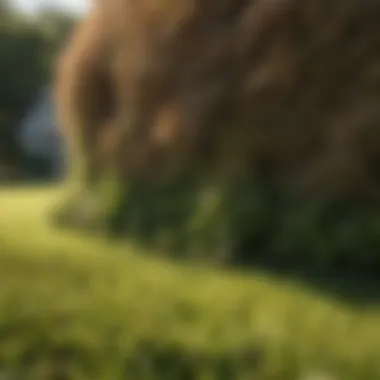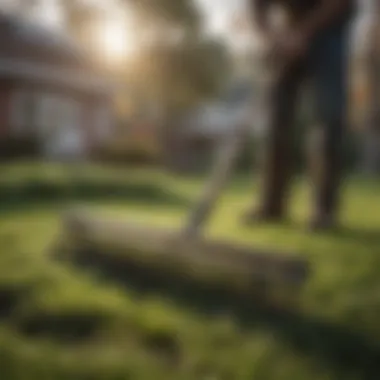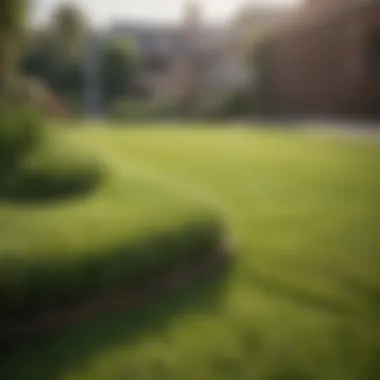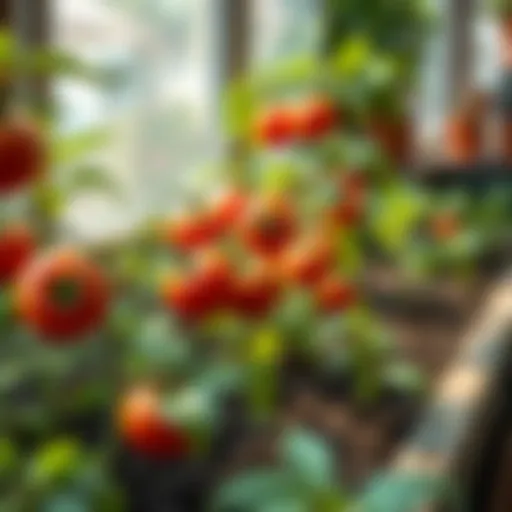Effective Techniques for Dethatching Your Yard


Intro
When it comes to keeping a lawn looking its best, many homeowners often overlook a critical aspect: dethatching. A thatch layer, which consists of dead grass, leaves, and roots, can build up and hinder your grass from receiving the water, air, and nutrients it desperately needs. It is more than just an unsightly accumulation; it can lead to dead patches and poor grass health. Understanding the practice of dethatching and its significance can elevate your landscaping game.
Dethatching isn't just a chore; it’s a vital step towards cultivating a vibrant lawn. In this guide, we will explore various techniques, the best timing for dethatching, and the tools required to tackle the task efficiently. For both seasoned garden warriors and novices dipping their toes in outdoor maintenance, these insights can prove to be pointers that guide you towards a greener tomorrow.
Key Insights and Trends
Current Trends in Lawn Care
The world of lawn care evolves, and 2023 has seen a surge in interest around sustainability. Homeowners are increasingly leaning towards organic methods that reduce chemical usage. This shift impacts dethatching as many gardeners prefer electric dethatchers or even hand tools, reinforcing the trend for eco-friendly practices in yard maintenance. Moreover, lawn care services that focus on integrated pest management are gaining traction, showcasing a broader understanding of how a healthy soil ecosystem contributes to a thriving lawn.
Popular Gardening Techniques of the Season
As we embrace spring and summer, some gardening techniques are capturing interest. Aeration, often paired with dethatching, allows better airflow and can complement the dethatching process. Using compost topdressing post-dethatching helps rejuvenate the soil and encourages healthier grass growth. It’s worth noting that these techniques dance hand-in-hand to create an environment where grass can flourish, making your yard the envy of the neighborhood.
Practical Tips and How-To Guides
Step-by-Step Guide to Dethatching
- Determine the Need for Dethatching: Inspect your lawn for thick layers of thatch over half an inch. If the thatch is coarse and brown, it's time to dethatch.
- Choose the Right Time: Late spring or early fall is the ideal time for dethatching. Wait until grass is actively growing to allow it to recover quickly.
- Select the Right Tools: You may opt for a mechanized dethatcher or a manual rake. Electric dethatchers are efficient and reduce physical strain, but traditional rakes can give you a good workout.
- Prepare Your Lawn: Mow your grass to about two inches before dethatching. This reduces the stress on your lawn during the process.
- Dethatch: Move the dethatcher across your lawn in different directions, ensuring even coverage. For manual rakes, it requires more effort but is equally effective.
- Clean Up: Remove the debris gathered and compost it or use it in your garden as mulch.
- Water and Feed: After dethatching, provide adequate water and consider applying a fertilizer or compost to nourish the grass as it recovers.
Post-Dethatching Care
The process doesn’t end after dethatching. Here's how to keep your lawn healthy:
- Water Regularly: Ensure consistent moisture.
- Apply Fertilizer: A balanced fertilizer will help stimulate growth.
- Monitor Health: Keep an eye on the lawn for any signs of stress or disease.
Understanding Thatch in Lawns
When it comes to maintaining a lush, vibrant lawn, understanding thatch is an essential part of the equation. Thatch, while often overlooked, plays a significant role in the health of grass. This organic layer forms on the surface of the soil, made up of a mix of living and dead grass roots, stems, and other organic debris. If managed properly, thatch can benefit your lawn by retaining moisture and providing a cushion for the grass. However, let it go unchecked, and it can suffocate your grass and encourage pests and diseases.
What is Thatch?
Thatch can be understood as a layer that sits between the soil and the green grass above. Typically, a small amount of thatch is perfectly normal, but when it thickens—generally more than half an inch—it can turn into a problem. This dense mat can inhibit water, air, and nutrients from seeping through to the soil, leaving the grass plants struggling for the essentials they need to thrive. Think of it like a barrier: your lawn may look lush on the surface, but beneath that beautiful green, it could be gasping for breath.
Causes of Thatch Buildup
There are several reasons why thatch accumulates in lawns. Here are some common culprits:
- Over-fertilization: Using nitrogen-rich fertilizers boosts grass growth but can lead to excess organic matter buildup.
- Improper Mowing: Cutting the grass too short or less frequently allows grass clippings to develop into thatch.
- Poor Soil Aeration: If the soil isn't aerated regularly, it can lead to compaction, promoting thatch formation.
- Slow Decay of Organic Material: In cooler climates, the breakdown of grass clippings and other organic matter can be sluggish, leading to accumulation.
Recognizing these factors can aid in preemptive action against thatch and help promote a healthier lawn.
The Importance of Thatch Management
Managing thatch isn't merely an aesthetic concern; it’s essential for the overall health of your lawn. Addressing thatch accumulation can bring the following benefits:
- Improved Water Penetration: Less thatch means better absorption of water, leading to healthier roots.
- Enhanced Nutrient Uptake: By removing excess thatch, nutrients can easily reach the soil and be absorbed by the grass roots.
- Reduced Soil Compaction: Thatch management promotes soil aeration, reducing the risk of compacted soil problems.
- Decreased Pest Problems: Thick thatch can harbor pests and disease; managing it can reduce these risks significantly.
To sum it up, staying on top of thatch management through regular monitoring and dethatching can leave homeowners with a green space that not only looks good but feels good too.
Recognizing Signs of Thatch Accumulation
Understanding thatch is important, but knowing how to spot its buildup makes all the difference. Thatch accumulation can silently sneak up on even the most diligent of homeowners. By recognizing early signs, you can take proactive measures to maintain a healthy lawn. Failing to notice thatch can result in a range of problems, from poor grass health to water drainage issues. So, let's dive into how to spot thatch before it becomes a headache.
Visual Indicators
A bit of observational skill goes a long way when assessing your lawn’s health. Look for a fuzzy or carpet-like layer just above the soil. When you run your hand over the grass, if it feels thick and spongy rather than firm and flat, that’s your first clue something might be up.
- Dark green clumps of grass can signal compacted layers beneath, indicating excessive thatch.
- Dry and brown grass tips might show that the deeper grass roots are struggling to access required nutrition and moisture.
"If you’re seeing areas of grass that simply look tired or lifeless, it’s time to roll up your sleeves."


Check for bare patches, too. These patches often signal poor grass growth, which can stem from too much thatch preventing water and nutrients from reaching the roots.
Health of Grass Plants
Next up, it's all about the grassroots. Literally. Healthy grass plants usually exhibit sturdy root systems that can withstand heat and drought. But if your lawn seems to wilt easily or struggle with color, check its roots. Pull up a handful of grass. If the roots are short, brown, or mushy, that’s a telltale sign the grass is having a tough time having access to the soil.
- Stunted growth despite regular watering should raise a red flag.
- Weeds may have taken over areas where they shouldn’t be. Thatch can encourage weeds as they thrive when grass is weak.
Soil Moisture Levels
How your soil behaves during watering can also be an indicator of thatch levels. Watering the lawn should ideally lead to quick absorption. However, if you notice standing water or areas remaining soggy for longer than expected, that may signal that there’s a barrier of thatch. It’s like placing a sponge on a sponge; moisture can't penetrate properly.
- If you’re overwatering due to this, it becomes a vicious cycle of encouraging more thatch buildup.
- Aim to use a moisture meter to gauge how well water enters the soil.
By being observant and proactive about these signs, you position yourself to tackle thatch effectively, leading to a lush, green oasis right in your backyard.
Timing Your Dethatching Efforts
When it comes to nurturing a thriving lawn, timing is everything. Knowing when to tackle the task of dethatching can make a huge difference in the effectiveness of your efforts. Dethatching is not just about ripping through that surface layer; it's about selecting that sweet spot in the seasonal cycle where your grass can bounce back and flourish. Not to mention, doing it at the right time can lessen the stress on your lawn, leading to better results in the long run.
Best Seasons for Dethatching
Generally speaking, the best times to dethatch your yard are during the spring and fall. Both seasons provide distinct advantages:
- Spring: As temperatures begin to warm up and the grass comes out of dormancy, this is often viewed as the prime time for dethatching. It’s when grass is gearing up for robust growth, making it easier for the lawn to recover post-dethatching. If you live in a warm climate, aim for late spring, while cooler areas might benefit from early spring. However, timing can vary based on your local climate and type of grass.
- Fall: For more temperate zones, fall can also be a favorable period. The grass is generally more resilient as it begins to prepare for winter dormancy. Dethatching at this time helps rejuvenate the lawn and allows it to gather strength before the colder months. The cooler weather also reduces heat stress, benefiting the recovery process.
When planning your dethatching efforts, it’s crucial to consider your specific grass type, as cool-season grasses and warm-season grasses have different growth cycles.
Ideal Weather Conditions
The weather plays a significant role in the dethatching process. Ideal conditions are those that promote grass growth while minimizing stress:
- Overcast Days: If you can, choose a day with overcast skies for dethatching. The cloud cover will prevent direct sunlight from stressing the grass after it has been dethatched, allowing it some shelter as it begins to heal.
- Slightly Damp Soil: Another golden rule is to avoid dethatching when the soil is either too dry or too soggy. Slightly damp soil allows for easier access to the thatch layer without damaging the grass roots. Aim to dethatch shortly after a light rain.
- Moderate Temperatures: Ideally, you want temperatures hovering around 60 to 75 degrees Fahrenheit. Too much heat can put your lawn under undue stress, hindering recovery. Conversely, doing it when temps are too low can also stunt the growth necessary for a healthy lawn.
Important Note: Always observe the underlying condition of your lawn before and after dethatching. This will help you determine if you've targeted the right time and methods for your specific environment.
Dethatching may seem like a simple chore, but taking the time to plan around these essentials can lead to a full, lush lawn that's the envy of the neighborhood. The right timing, combined with suitable weather conditions, can turn a challenging task into a worthwhile investment in your yard's health.
Tools and Equipment for Dethatching
Having the right tools and equipment for dethatching is vital. Just like a good craftsman wouldn't use a rusty hammer, your lawn deserves the best to stay healthy and vibrant. The tools you choose can affect not only the efficiency of the dethatching process but also the long-term health of your grass. Using inadequate or inappropriate tools may leave you frustrated and the lawn worse off than before. Don't be caught empty-handed; knowing what to use is half the job.
Manual Dethatching Rakes
Manual dethatching rakes are the unsung heroes in the dethatching process. These rakes are designed to remove thatch without tearing up healthy grass. The serrated blades effectively pull up the dead grass and debris, allowing for better air and moisture penetration.
Using a manual rake calls for some elbow grease, but it gives you an intimate connection with your lawn.
Here's what to keep in mind about manual dethatching rakes:
- Cost-Effective: They are generally cheaper than power tools, making them accessible for most homeowners.
- Control: You have more control over how aggressive you want to be in removing thatch.
- No Power Needed: They are eco-friendly, needing no electricity or gas.
The downside? If you’re dealing with a large area, this can be time-consuming. But, if you're just tackling a small patch, a manual rake could be all you need to get the job done.
Power Dethatching Machines
Power dethatching machines, or dethatchers, offer efficiency that manual tools often can't match, especially when tackling large yards. These machines work by using a series of rotating blades or tines to cut into the thatch layer and pull it to the surface. Not only does it save you time, but it can also be less physically demanding.
When considering a power dethatching machine, keep these factors in mind:
- Variety of Options: You can find gas, electric, or even rental options. Each has its pros and cons depending on your frequency of use.
- Width of Cut: Machines come in various widths. Wider cuts mean less passes over the lawn, which cuts down on your time.
- Adjustable Heights: Look for machines that allow you to adjust the height of the tines to prevent unnecessary stress on active grass.
However, investing in a machine is a bigger commitment. You'll need to consider storage space and maintenance as well, so choose wisely.
Other Essential Tools
In addition to rakes and machines, having a few other tools on standby can make the dethatching experience smoother and more effective:


- Lawn Mower: A good lawn mower can help in keeping your grass at the optimal height prior to dethatching. Too high and you might risk breaking blades during the dethatching process.
- Leaf Blower: After dethatching, a leaf blower can help scatter the debris for easy pickup.
- Gardening Gloves: Protect your hands when handling the dethatching tools and cleaning up afterward.
- Tarp or Compost Bin: Gather up thatch and clippings efficiently to either compost or dispose of them.
Ultimately, the tools you choose will depend on the size of your lawn, your comfort level, and your budget. Investing in good quality equipment pays off in the long run by preserving the health of your lawn for seasons to come.
Step-by-Step Guide to Dethatching
Understanding the steps involved in dethatching your lawn is like knowing the ins and outs of baking a cake. The ingredients matter, as does the method. This guide aims to provide you with a systematic approach to dethatching, ensuring that your lawn not only survives the process but thrives afterwards. Think of dethatching as a rejuvenation for your grass, helping it grow healthier and greener.
Preparation of the Lawn
Before embarking on this undertaking, you need to prepare the lawn appropriately. Failing to do this stage can lead to less-than-ideal results.
- Mow the Lawn: Begin by mowing your grass to a height of about one to two inches. This allows for easier access to the thatch layer, making the dethatching process smoother.
- Water the Soil: Watering your lawn a day or two before you plan to dethatch is also crucial. A slightly moist surface can make the process more efficient, as the soil is easier to pierce through with tools and you reduce the risk of damaging your grass roots.
- Mark Obstacles: If there are any hidden features in your yard—like sprinkler heads or underground cables—mark them clearly. You wouldn’t want to accidentally damage anything while dethatching!
These preparations lay the groundwork you need to ensure a successful dethatching operation.
Dethatching Process
With everything set and ready, you can now dive into the actual dethatching process. It’s not rocket science, but it requires attention to detail.
- Choose the Right Tool: Depending on the size of your yard and the severity of the thatch, decide whether to use a manual dethatching rake for smaller patches or power dethatchers for larger areas. The latter might feel like overkill, but it can save you tons of time.
- Begin Dethatching: Start at one edge of the lawn and work your way across. If using a power dethatcher, run it in two directions to ensure thorough coverage. You want to get rid of as much thatch as possible, not just skim the surface.
- Watch Your Progress: It's important to frequently stop and assess your work. Make sure you’re not pulling up too much soil along with the thatch. It can be a fine line to balance, so keep your eyes peeled.
The dethatching process, though laborious, is essential for the health of your lawn. While you might find it tedious, knowing you’re doing something beneficial can make it worthwhile.
Cleaning Up After Dethatching
Once you’re done dethatching, it’s time to clean up. This is just as important as the dethatching itself. A neat finish can help your lawn recover faster.
- Rake Up the Debris: Use a rake to gather the debris left behind. This might include clumps of grass, thatch, and other organic matter. Don’t leave it lying around, or it can lead to more buildup.
- Dispose or Compost: You can either bag the removed thatch or add it to your compost pile. The choice depends on your gardening practices; just ensure to manage it appropriately.
- Repair Damaged Spots: Some grass may have been damaged during the dethatching process. If you notice any bare patches, consider reseeding them to promote new growth.
"Cleaning up after dethatching is not just about aesthetics; it's about giving your lawn a fresh start."
Completing these steps carefully will maximize the benefits of dethatching.
Taking the time to prepare, execute, and clean will ensure your lawn receives the care it needs for a vibrant future.
Post-Dethatching Care
After going through the effort of dethatching your lawn, it's crucial to consider the next steps to help your grass bounce back. Post-dethatching care is not just a simple afterthought; it plays an enormous role in ensuring your lawn thrives. Essentially, you're giving your turf the best chance to heal and grow strong and lush.
Watering the Lawn
Right after you finish dethatching, watering becomes vital. The soil can become compacted during the dethatching process, so applying water helps loosen it up again. The key is to soak the lawn instead of just sprinkling. Aim for about one inch of water per week, covering all areas uniformly. Monitor your lawn; if it's looking dry or the color is fading, it’s time to turn on the hose.
More than simply keeping the grass hydrated, watering also aids in the absorption of nutrients that will be crucial for recovery. Remember, early mornings are the best time to water; this encourages deep root growth and minimizes evaporation.
Fertilization Strategies
Fertilizing your lawn post-dethatching can be a game changer. After all, dethatching can strip away more than just thatch; it may disturb some essential soil nutrients as well. Using a slow-release fertilizer will ideally replenish this nutrient loss.
A balanced fertilizer, typically labeled with an NPK ratio such as 10-10-10, can all but kick-start lawn recovery. Also consider organic options, like compost or manure, as these not only act as fertilizers but improve soil structure too.
When applying fertilizer, always follow the instructions on the package. Too much can lead to excess growth but also burn the grass, which is a situation to steer clear of. Give your lawn about four to six weeks to absorb the nutrients, then take a look—you should see fresh green blades pushing through soon.
Overseeding for Recovery
After dethatching and fertilizing, overseeding your lawn can significantly aid recovery. This is all about enhancing density and filling in gaps where the grass might be thin or uneven. Choose a seed variety that matches what’s already growing, ensuring that the established grass and newly seeded patches coexist harmoniously.
To overseed, simply spread the seed evenly and water lightly but often, keeping the soil consistently moist until the seeds germinate. This step is about promoting that lush, full appearance that every homeowner dreams of. It's also a great idea to wait for ideal weather conditions—mild temperatures and a bit of moisture in the air can work wonders.
"An ounce of prevention is worth a pound of cure." This old saying rings true when it comes to lawn care, especially after dethatching. The more effort you put into the health of your grass now, the more you'll reap the rewards later.
By prioritizing post-dethatching care—proper watering, well-timed fertilization, and strategic overseeding—you’re ensuring that your lawn doesn’t just survive but thrives. While dethatching gives your lawn a fresh start, with proper care, you provide the nurturing it needs to flourish.


Common Mistakes to Avoid
When it comes to dethatching a yard, figuring out the rhythm of your lawn’s needs is crucial. Understanding common mistakes can save time, effort, and may just be the key to a thriving green space. This section dives into two major pitfalls seen often by homeowners: dethatching too often and ignoring lawn health.
Dethatching Too Often
It might sound tempting to want to keep your lawn pristine at all costs. However, dethatching too frequently can actually do more harm than good. The process of dethatching removes thatch build-up, allowing for better water and nutrient absorption. But hitting it with the rake or machine too often can lead to more exposure of the soil. This disruption can stress grass plants and weaken the turf overall.
Consider this: a healthy yard has a certain amount of thatch, providing benefits such as enhancing moisture retention and sheltering beneficial insects. If you dethatch unnecessarily, the protective layer can thin out, exposing the roots and leading to increased vulnerability to pests and disease. Stick to the recommended schedule, typically once a year for cool-season grasses in the spring or for warm-season varieties in late summer or early fall. Here are some quick guidelines to avoid frequent dethatching:
- Assess the thatch level before taking action.
- Watch for signs of stress in your grass after dethatching.
- Give your lawn time to recover after each session.
Ignoring Lawn Health
Another common error is overlooking the overall health of the lawn. It’s easy to get caught up in the mechanics of dethatching without taking the time to assess the underlying conditions affecting your grass. A lawn in trouble can’t fully benefit from dethatching; neglecting to identify issues like poor soil quality, inadequate watering, or nutrient deficiencies undermines your efforts.
Before you start dethatching, keep an eye out for these signs:
- Discoloration: Yellowing patches often indicate issues.
- Thin areas: If certain patches aren't growing as well, that's a concern.
- Weed overgrowth: Weeds can often indicate an imbalance in your lawn’s health.
Addressing these problems beforehand can make a world of difference. Fertilization, aeration, or, even just a simple watering schedule can set the stage for a successful dethatching process. Remember, don’t simply react to thatch buildup; taking a holistic approach ensures longer-lasting results.
"A well-maintained lawn is a happy lawn. If you treat it like a friend, it will repay you in lush beauty and serenity."
By avoiding these two common pitfalls, homeowners can improve their chances of achieving a lush, sustainable landscape. The essence of lawn care lies in observing, understanding, and guarding the health of your turf first and foremost.
Evaluating Results After Dethatching
After putting in the hard work of dethatching your lawn, it’s only natural to want to see some results. Evaluating the outcomes of your dethatching efforts helps ensure that you’ve set the stage for a vibrant, healthy lawn. This process not only gives you a sense of accomplishment but also provides insights into what worked and what may need adjustments in your ongoing lawn care routine.
Assessing Grass Health
The health of your grass is one of the most direct indicators of how successful your dethatching has been. After dethatching, look closely at the color and texture of your grass. Ideally, you should be seeing lush, green blades that stand upright. If your grass appears yellow or patchy, that might mean it needs more support.
- Check for Recovery: Post-dethatching, it’s important to monitor how quickly the grass recovers. A vigorous regrowth indicates successful dethatching, while slow recovery could signal problems.
- Look for New Growth: The presence of new shoots is a good sign. If you see tiny sprouts emerging, that’s a positive sign!
- Weed Encroachment: Healthy grass can usually fend off weeds. If you notice weeds sprouting up after dethatching, your grass may not be robust enough yet.
"A healthy lawn is a proud accomplishment. It reflects attention to detail and heartfelt effort."
Observing Soil Improvements
Soil health is equally important as grass health. Effective dethatching can lead to noticeable changes in your soil's quality, which in turn supports the grass’s growth and overall yard vitality. After dethatching, take some time to review the soil conditions.
- Moisture Levels: Check if the soil retains moisture better than before. Healthy soil should have good drainage but still feel moist a day or two after watering, which is crucial for grass recovery.
- Structure and Aeration: Dethatching can improve soil aeration, allowing roots to breathe. Dig a small hole and examine the soil structure; it should crumble easily without being too compacted.
- Microbial Activity: The presence of earthworms and other beneficial organisms indicates improved soil health. Healthy soil is usually teeming with life, which is a great sign for ongoing lawn care.
In summary, evaluating the results after dethatching offers an opportunity to reflect on your efforts. By assessing grass health and observing soil improvements, you can determine how successful your dethatching was and make any necessary adjustments moving forward. This step is vital for ensuring that your lawn continues to flourish.
Additional Lawn Care Practices
Lawn care doesn’t solely revolve around dethatching; it's an ongoing journey that requires multiple complementary practices for overall health and aesthetics. Incorporating additional techniques can ensure you're not just removing thatch, but also enhancing the vitality of your grass. After all, a flourishing lawn is often the result of combined approaches to caring for your yard.
Aeration: Complementary Technique
Aeration is like giving your lawn a breather after its workout. This process involves perforating the soil with holes to allow air, water, and nutrients to penetrate deep into the roots. When you dethatch, the grass might feel a bit stripped, and aeration serves as a way to replace what’s lost. It improves root development, promotes healthier grass, and can dramatically improve your lawn's resilience against stress.
Benefits of Aeration:
- Enhanced Water Absorption: Holes in the soil facilitate better water infiltration, which means less runoff and more hydration for your grass.
- Improved Nutrient Uptake: With aeration, nutrients can reach deeper layers of soil, allowing plants to absorb what they need more effectively.
- Reduction of Soil Compaction: Regular aeration can lessen soil compaction, a common problem in lawns that undergo heavy foot traffic.
Aeration should ideally be done just before dethatching in the spring or early autumn. This timing allows benefits from both practices to compound, resulting in greener and thicker grass.
Regular Mowing Practices
Mowing is an everyday element of lawn care that significantly impacts your lawn’s health. When you mow regularly, you're not merely keeping your grass short; you're also stimulating growth. Frequent cutting encourages grass to grow denser and leads to improved light penetration which is vital for lower grass levels.
Considerations for Effective Mowing:
- Mow at the Right Height: Different grass types have different ideal cutting heights — for instance, Bermuda grass should be mowed to about 1 to 2 inches, while taller varieties like fescue might benefit from heights of 3 to 4 inches. Mowing too short can stress the plants and lead to a weakened lawn.
- Keep Blades Sharp: Dull blades tear rather than cut, leaving grass vulnerable to diseases. A clean cut not only makes the lawn look better but maintains overall health by reducing damage.
- Mow When Dry: Grass that’s wet can clump and create uneven cutting. It’s best to mow during cooler parts of the day, either early morning or late afternoon when the grass is dry to ensure precision cuts.
By implementing these additional practices alongside dethatching, you create a well-rounded approach to your lawn maintenance. It is about nurturing and understanding different needs throughout the seasons.
Remember: A healthy lawn is like a good recipe; it's a blend of the right ingredients and techniques mastered over time.



